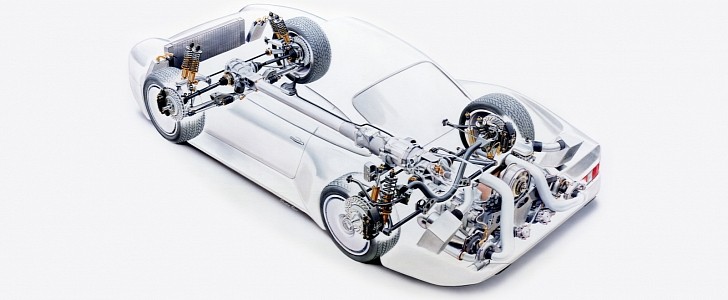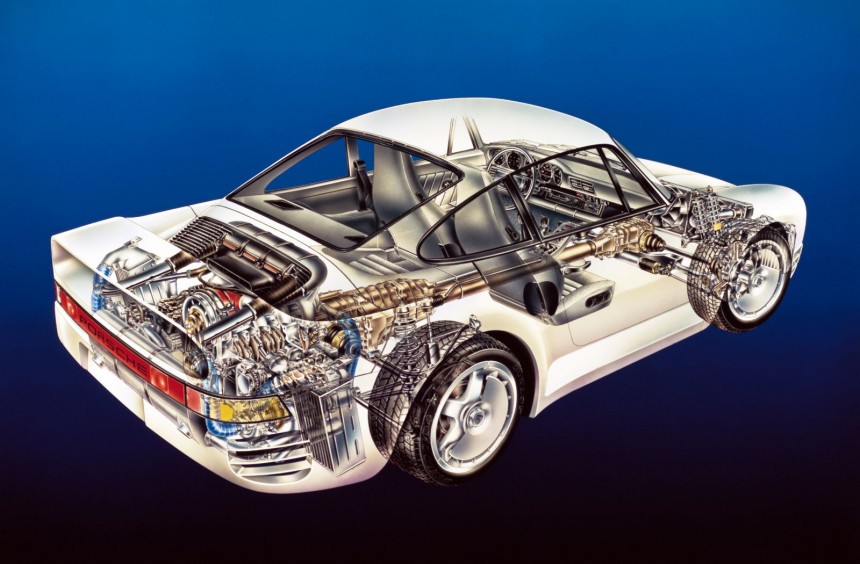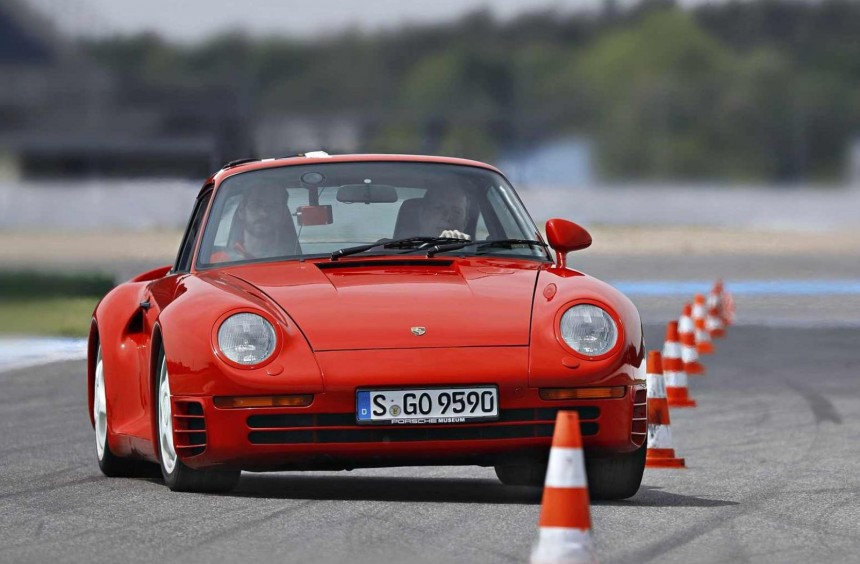Shortly after World War II, when Willys Overland decided to sell a civilian version of the iconic Jeep, four-wheel-drive systems started to receive more interest from the automotive industry. Other companies went on to develop their own versions, but for the following decades, its use remained limited to utilitarian vehicles.
This began to change in the 1960s with the introduction of the luxury-oriented Wagoneer, and by the 1980s, Subaru or Audi were rolling out passenger cars with 4WD capabilities.
In 1986, Porsche would go one step further when the company launched the legendary 959, a surprisingly sophisticated homologation model initially developed to rule the rally world. Arguably the most technologically advanced supercar of the era, it stood out thanks to the Porsche-Steuer Kupplung (PSK). This electronic-controlled 4WD system remains one of the most advanced ever created.
Back then, most 4WD systems had a permanent torque split under normal driving conditions, with variations occurring only when wheel slip was detected. What made the PSK unique, was its ability to vary torque split not just when one of the tires was slipping but also in normal driving conditions.
Due to the splitting, this revolutionary system used a multi-plate clutch with six pairs of frictional plates instead of a conventional central differential. An onboard computer independently controlled each pair via high-pressure hydraulics, which meant that, as a whole, the lone unit could function as six individual clutches.
During development, engineers realized that the only way to make this system run as intended was to have the front and rear driveshafts moving at different speeds. The solution was simple yet extremely clever: use different diameter tires on each axle. Thus, the 959 received front tires that were 1% larger in diameter than those on the rear.
Because of the speed difference between the driveshafts, the frictional plates of each independent clutch were rotating relative to each other. When hydraulic pressure was applied to the first clutch, a small amount of torque would transfer to the front axle. Furthermore, if additional clutches were engaged, the engine could deliver even more torque to the front. When all six pairs were engaged, both driveshafts would fully lock up for an even 50:50 split.
Like I mentioned earlier, this was controlled by the onboard computer using multiple sensors that monitored g-force, throttle position, steering angle, or turbo boost to determine the optimum split. Additionally, the driver could manually choose between four different 4WD modes of operation using a dial in the cockpit.
As standard, the car has a 40:60 front/rear split that maximized weight distribution but, during hard acceleration, when a large part of the weight was transferred to the rear, up to 80% of the torque was delivered to that axle to maximize traction.
The 959 was not only blistering quick for its time, achieving a 0-to-60-mph (97 kph) time of 3.6 seconds, but stood out for its near-perfect handling and outstanding traction in precarious conditions. Coupled with the innovative adjustable suspension, the PSK made this amazing Porsche the only true daily driver supercar of its era.
Before the release of the road-going 959, the rally cars that used this pioneering system were so good that they managed to win the prestigious Paris-Dakar Rally in 1984 and 1986.
In large part, because of the high development costs and complexity, the German manufacturer chose not to develop the system further, and the 959 remained the only mass-produced model to employ the PSK. However, the use of 4WD systems didn’t stop there, as the technology was later introduced in other Porsches.
Now 35 years old, the PSK remains one of the most revolutionary systems of its kind. It introduced features that are still in use today. and its use in the 959 inspired other manufacturers to create 4WD supercars.
In 1986, Porsche would go one step further when the company launched the legendary 959, a surprisingly sophisticated homologation model initially developed to rule the rally world. Arguably the most technologically advanced supercar of the era, it stood out thanks to the Porsche-Steuer Kupplung (PSK). This electronic-controlled 4WD system remains one of the most advanced ever created.
Back then, most 4WD systems had a permanent torque split under normal driving conditions, with variations occurring only when wheel slip was detected. What made the PSK unique, was its ability to vary torque split not just when one of the tires was slipping but also in normal driving conditions.
During development, engineers realized that the only way to make this system run as intended was to have the front and rear driveshafts moving at different speeds. The solution was simple yet extremely clever: use different diameter tires on each axle. Thus, the 959 received front tires that were 1% larger in diameter than those on the rear.
Because of the speed difference between the driveshafts, the frictional plates of each independent clutch were rotating relative to each other. When hydraulic pressure was applied to the first clutch, a small amount of torque would transfer to the front axle. Furthermore, if additional clutches were engaged, the engine could deliver even more torque to the front. When all six pairs were engaged, both driveshafts would fully lock up for an even 50:50 split.
Like I mentioned earlier, this was controlled by the onboard computer using multiple sensors that monitored g-force, throttle position, steering angle, or turbo boost to determine the optimum split. Additionally, the driver could manually choose between four different 4WD modes of operation using a dial in the cockpit.
The 959 was not only blistering quick for its time, achieving a 0-to-60-mph (97 kph) time of 3.6 seconds, but stood out for its near-perfect handling and outstanding traction in precarious conditions. Coupled with the innovative adjustable suspension, the PSK made this amazing Porsche the only true daily driver supercar of its era.
Before the release of the road-going 959, the rally cars that used this pioneering system were so good that they managed to win the prestigious Paris-Dakar Rally in 1984 and 1986.
In large part, because of the high development costs and complexity, the German manufacturer chose not to develop the system further, and the 959 remained the only mass-produced model to employ the PSK. However, the use of 4WD systems didn’t stop there, as the technology was later introduced in other Porsches.
Now 35 years old, the PSK remains one of the most revolutionary systems of its kind. It introduced features that are still in use today. and its use in the 959 inspired other manufacturers to create 4WD supercars.









